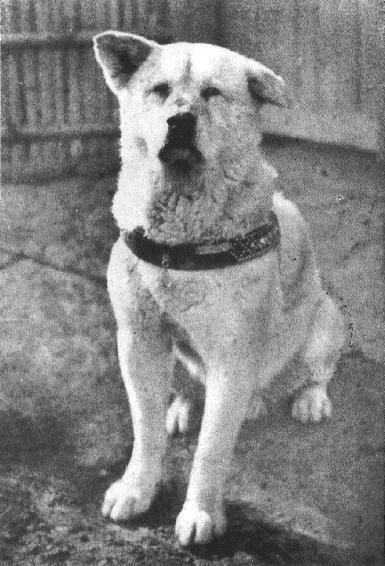
The real Hachiko…
Hachiko was born on a farm near the city of Odate in the Akita Prefecture in 1923. His name Hachiko means – “hachi” meaning eight which refers to his order of birth from the litter; and ko meaning prince or duke. To the Japanese he was often referred to as ‘chuken Hachiko’ or faithful dog Hachiko for that was exactly what his story was about …. love and loyalty.
In 1924, Professor Hidesaburō Ueno took in the Akita puppy, Hachiko as a pet. Over the next year or so pet and master developed a very close bound. They have developed a daily routine where Hachiko would see Professor Ueno out to the door of the Shibuya train station and be there again at the end of the day when he would greet his master and they would walk back home together. The pair continued their daily routine until May 1925, when Professor Ueno did not return on the usual train one evening. The professor had suffered a cerebral hemorrhage at the Tokyo University where he was teaching. He died and never returned to the train station where his faithful dog and friend was waiting. But every single day Hachiko wold return to the Shibuya train station at the expected time of the professor’s return…he did this for the next nine years.
After the professor’s death Hachiko was given away to a different owner, but he would routinely escape returning again and again to his old home. Eventually, Hachikō realized that Professor Ueno no longer lived at the house. So he went to look for his master at the train station where he had accompanied him so many times before. Each day, Hachikō waited for Professor Ueno to return. And each day he did not see his friend among the commuters at the station.
Hachiko became a permanent fixture at the train station and attracted the attention of the commuters.Many of the people who frequented the Shibuya train station had seen Hachikō and Professor Ueno together each day. They brought Hachikō treats and food to nourish him during his wait.
That same year, a student of Professor Ueno who had become an expert in the Akita breed, saw Hachiko at the train station and followed him home. He found Hachiko at the home of the professor’s former gardener,Kikuzaboro Kobayashi, there he learned the history of Hachiko’s life.Shortly after this meeting, the former student published a documented census of Akitas in Japan. His research found only 30 purebred Akitas remaining, including Hachikō from Shibuya Station
Over the years Professor Ueno’s student frequently returned to the Shibuya station to see Hachiko, he also published several articles about Hachiko’s remarkable loyalty. Then in 1932 one of these articles ended up at the one of Tokyo’s largest newspaper circulation, this threw the dog into a national fame. Hachikō became a national sensation. His faithfulness to his master’s memory impressed the people of Japan as a spirit of family loyalty all should strive to achieve. Teachers and parents used Hachikō’s vigil as an example for children to follow. A well-known Japanese artist rendered a sculpture of the dog, and throughout the country a new awareness of the Akita breed grew.
Eventually, Hachiko’s remarkable faithfulness became a national symbol of loyalty.
In April 1934, a bronze statue in his likeness was erected at Shibuya Station, and Hachikō himself was present at its unveiling.
On March 8, 1935 Hachiko was found dead on a street in Shibuya.His heart was infected with filarial worms and 3-4 yakitori sticks were found in his stomach. Out of deference for this remarkable dog, his remained were stuffed and mounted and are kept at the National Science Museum of Japan in Ueno, Tokyo.
Hachiko’s monument was destroyed during World War II but in 1948, The Society for Recreating the Hachikō Statue commissioned Takeshi Ando, son of the original artist who had since died, to make a second statue. The statue still stands up this day, and had become a tourist attraction and a popular meeting place for many. The station entrance near this statue is named “Hachikō-guchi”, meaning “The Hachikō Exit”, and is one of Shibuya Station’s five exits.
**** Information from Wikipedia
Annual Ceremony
Each year on April 8, Hachikō’s devotion is honored with a solemn
ceremony of remembrance at Tokyo’s Shibuya railroad station. Hundreds of
dog lovers often turn out to honor his memory and loyalty.
Film
Hachikō was the subject of the 1987 movie Hachikō-Monogatari
which told the story of his life from his birth up until his death and
imagined spiritual reunion with his master. Considered a blockbuster
success, the film was the last big hit for Japanese film studio
Shochiku Kinema Kenkyû-jo.Hachi: A Dog’s Story, released in August 2009, is an American movie starring actor Richard Gere, directed by Lasse Hallström, about Hachikō and his relationship with the professor. The movie was filmed in Rhode Island.
…..Several books were also written about. Including a recording of his bark, now I know that this is going overboard but…..
….In 1994, the Culture Broadcasting Network (CBN) in Japan was able to lift a recording of Hachikō barking from an old record that had been broken into several pieces. A huge advertising campaign ensued and on Saturday, May 28, 1994, 59 years after his death, millions of radio listeners tuned in to hear Hachikō bark. This event was testimony to Hachikō’s continuing popularity.

Hachiko’s stuffed and mounted remains at the National Science Museum at Ueno, Tokyo.

Hachiko’s statue at Shibuya Station

Walang komento:
Mag-post ng isang Komento